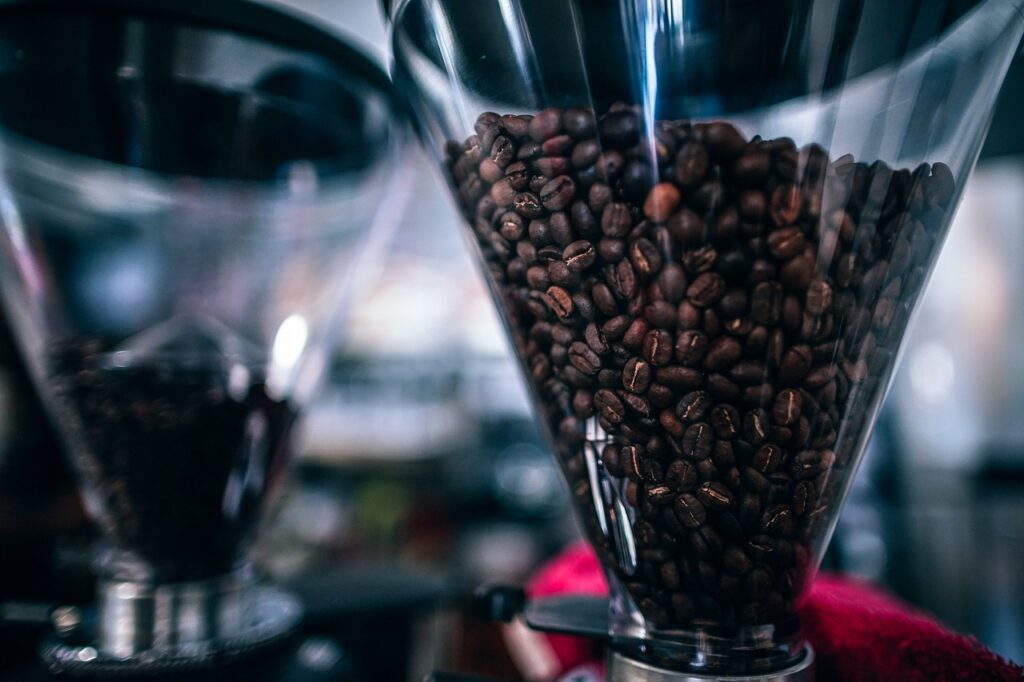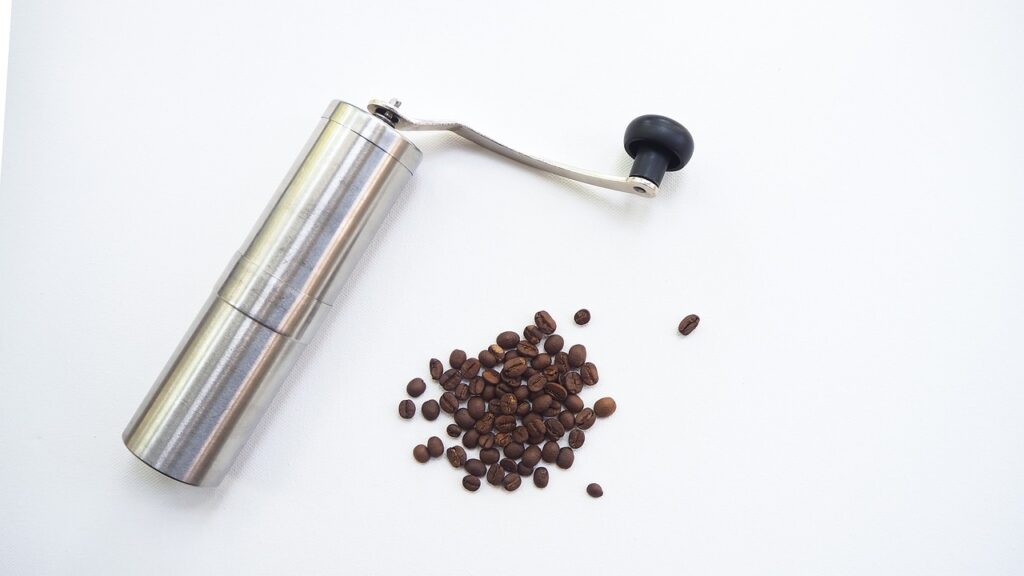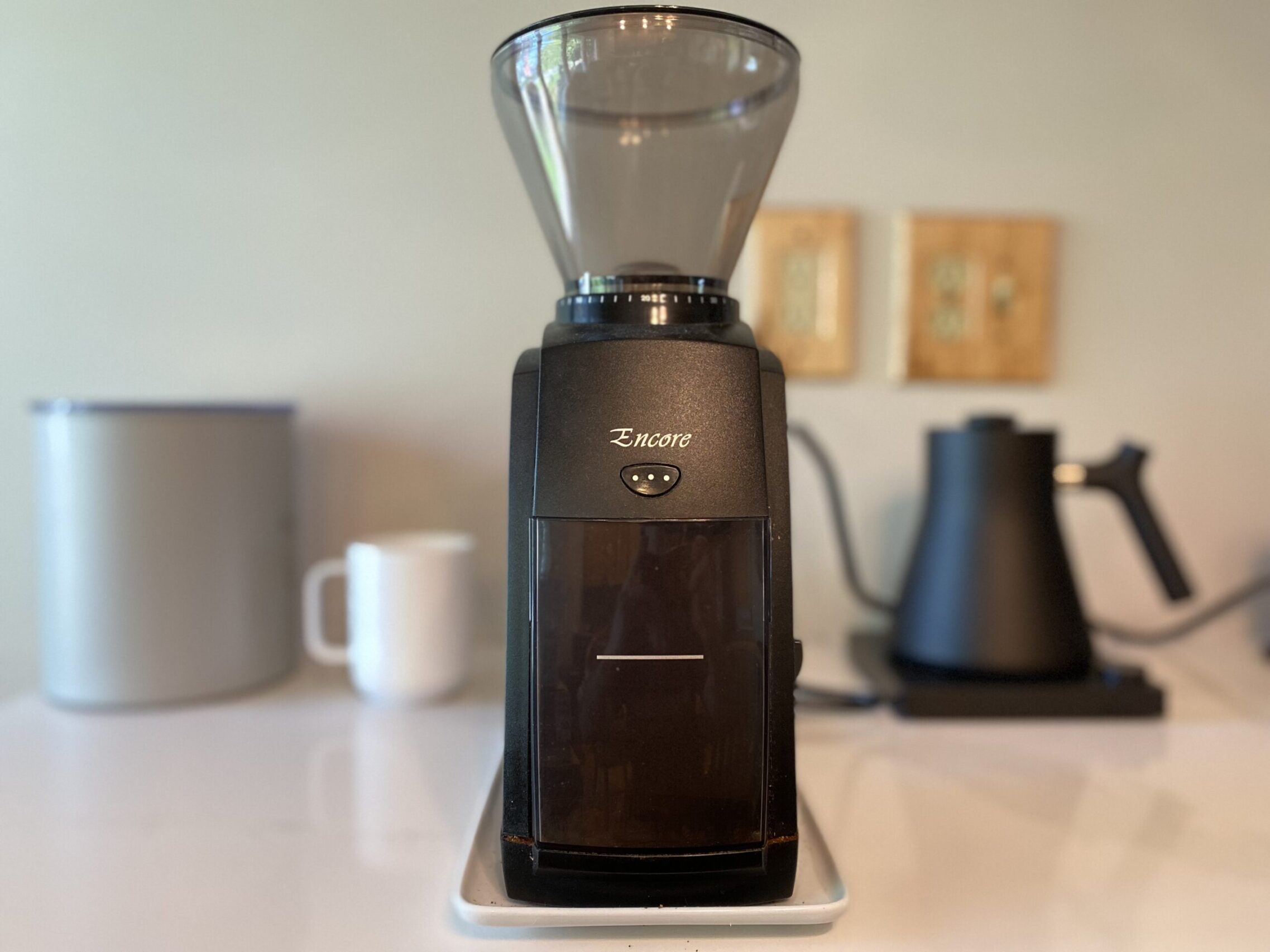If you’re looking for tips on how to buy a coffee grinder, first off, I commend you! I’ve said it before, and I’ll say it again: investing in a good coffee grinder is, in my opinion, the number one thing you can do to start brewing better coffee at home if you currently use pre-ground coffee.
In this guide to coffee grinders, I’m going to discuss…probably more than you want to know about grinders, the features you should look for, and what aspects of these pieces of equipment will make the most difference in your cup. But by the end, you’ll be an expert on grinders and will be fully equipped to find the ideal grinder for your needs. Let’s get started!
Why You NEED a Coffee Grinder
Before we get into how to buy a coffee grinder, I think it’s important to discuss why I think you need one in the first place. Is a grinder just another piece of equipment that people say you need to get you to spend more on your coffee setup? No, absolutely not. In my opinion, the grinder you buy is often more important than any other piece of equipment you have in your coffee-making arsenal.
First off, grinding your coffee right before you brew it means you’re actually drinking fresh coffee. Roasted coffee beans lose freshness over time, but you can maintain about peak freshness for a few weeks. The second you grind your whole coffee beans, you increase the surface area through which the coffee can lose flavor and compounds that provide a balanced cup of full-flavor coffee.
The volatile compounds — the ones that degrade over time and with exposure to moisture and oxygen — include:
- Ketones — impart fruity and floral notes
- Aldehydes — impart fruity and bright flavors
- Furanones — impart caramel and roasty flavors
- Furans — impart caramel and roasty flavors
- Pyrazines — impart nutty and roasty flavors
- Alcohols
- Esters
- Carboxylic acids
- Pyridines
- Pyrroles
- Hydrocarbons
- Phenols
As these compounds degrade, your coffee will lose flavor and mouthfeel, and, most importantly, the complexity that the roaster (hopefully) worked tirelessly to provide in the beans they roasted. Many of the compounds that remain — the non-volatile ones like caffeine, chlorogenic acids, and organic acids — will impart bitter and acidic flavors to your coffee.
Ever wondered why your coffee tastes overly bitter, mostly flavorless, and demands that you use milk and sugar? It’s probably because pre-ground coffee loses many of these volatile compounds in just a few minutes. And when you buy pre-ground coffee from a grocery store, it has very likely been sitting there or in storage for months. Yes…MONTHS.
Whole bean coffee still loses these volatile compounds but much more slowly. Grinding right before you brew will make an enormous difference.
What to Look for in a Coffee Grinder
Now that you know why a grinder is all but necessary, we can discuss what to look for when buying one so that you get the one that suits your budget and yields the best coffee possible. Any grinder is better than no grinder, but you should pay attention to a few key things for the best results. I’ll discuss what to look for in a good home coffee grinder below.
Manual Grinder vs Electric Grinder: Which Is Best?
The first thing you’ll have to decide is whether you want a manual or electric grinder. Both are good in their own way, so there’s no clear-cut answer here.
Manual grinders require you to turn the burrs — the parts that actually crush the coffee — using a crank, so grinding your coffee will take a bit of effort each morning. It’s also more time-consuming to use a manual grinder, unless you’re some superhuman who can reach the 550 RPM speeds that some electric grinders do. There’s just no way.

However, manual grinders almost always have higher-quality burrs in a given price range because you’re not also paying for a motor. They’re also portable, so they’re easy to travel with and can be brought to work for better coffee, on camping trips, skiing trips, backpacking excursions, or just about anywhere else you might want to go.
Electric grinders provide the opposite perks. They’re way faster — sometimes grinding up to around 5g of coffee beans per second! — and require no effort from you. However, they’re noisier, harder to take with you if you’re traveling, bulkier, heavier, and more expensive.
Ultimately, you’ll have to decide for yourself which suits you best. I personally have one really good manual grinder — the Lido 3 from Orphan Espresso — and one good electric grinder — the Baratza Virtuoso Plus.
Blade Grinder vs Burr Grinder: Which Is Better?
If you’ve decided on an electric grinder, you’ll need to choose between a blade grinder and a burr grinder. You should note that manual grinders don’t ever come with blades…at least not that I’ve ever seen.
A blade grinder uses blades to cut the beans into smaller and small pieces the longer you grind for. A burr grinder uses burrs to crush the beans into smaller pieces, and with a specific grind size, you’ll very rarely get uncharacteristically small pieces of coffee beans in your grounds and never uncharacteristically large pieces.
I’ll discuss why grind size consistency is important a bit later, but for now, know that I recommend against blade grinders. They are very affordable and probably will provide a pretty significant upgrade over using pre-ground coffee. However, they offer no consistency in grind size within a batch and among different batches. Investing in a cheap burr grinder will always be better than investing in even a high-end blade grinder.
Which Burr Type Is Best? Ceramic vs Stainless Steel vs Cast Iron
There are three materials you can choose from when it comes to your burrs: ceramic, stainless steel, and cast iron. However, you’ll really only have access to two of them: ceramic and stainless steel.
Ceramic burrs are the most affordable, so they can help keep upfront costs down. However, they’re the least durable and can crack if you drop your grinder. You may end up paying more in the long run if you buy a ceramic burr grinder. Plus, ceramic burrs aren’t as sharp as metal ones and provide less consistency in your grind size.
Stainless steel burrs are much harder and more durable than ceramic ones. They’ll last longer, won’t ever crack, and will provide more consistency in grind size due to their sharpness. Steel burrs also won’t rust. They are, however, more expensive than ceramic burrs, so they’ll drive up your upfront price a bit.
Coffee grinder burrs used to be made out of cast iron. You can still buy cast iron burrs, but the options are few and far between. They are the most durable option in terms of strength and retaining sharpness for consistency, but they’re prone to rusting. Even if you do find a cast iron burr grinder, I recommend against it. The material avoids heat build-up, but that’s not really important in a home grinder anyway.
Grind Size Consistency
Once you figure out which kind of grinder you want, you should immediately start thinking about the grind size consistency — also called the grind size distribution — each option provides.
Grind size consistency is important for two main reasons: first, consistent grounds in a single batch means the extraction will be even and balanced, which leads to a much better-tasting cup of coffee. Second, consistency from batch to batch means you can make small changes in grind size or other metrics, and you’ll see noticeable differences reflected in your cup.

I generally recommend prioritizing grind size consistency over most other factors. It will make the biggest difference in your coffee, and it gives you total control over how your coffee tastes.
Optimizing for the consistency of grind size distribution is a challenge. After all, there’s no metric that grinder manufacturers use to tell you how consistent their products are and the precision distribution you can expect. That would be great, but I’ve never seen that kind of measurement.
Instead, you either need to rely on reviews from people who have used the grinders you’re considering or just try them out yourself. As you might imagine, the grinders I recommend all have excellent consistency for their price range.
Flat vs Conical Burrs: Which Is Best and Why?
Burrs are the gear-like pieces that turn in your grinder and do the actual grinding. There are two types of burrs used: flat burrs and conical burrs.
Flat burrs are…flat…and they have an adjustable gap between them for the grounds to escape after they reach the desired size. Flat burrs are generally more consistent and have a tighter distribution of ground size, but they’re more expensive.
In a conical burr grinder, there’s one burr that’s shaped like a cone and another into which that one fits. The gap along the bottom of the cones allows coffee grounds to fall through once they’ve been ground down sufficiently. Conical burrs can still provide great consistency, and they’re more affordable.
So…which is better? As in most cases, the answer to this question depends on your preference and budget. I am comfortable recommending both, and I usually suggest conical burrs for people who are trying to keep costs down.
Another thing to consider is availability. Conical burrs are used much more widely, so you’ll find far more options for electric grinders if you’re looking for conical burrs. Additionally, I’ve never seen a manual grinder with flat burrs. A company called Pietro is apparently releasing one, but it’s not available yet.
Grind Size Range and Brewing Style Preference
As you might already know, different styles of brewing coffee demand different grind sizes; espresso grinds are super fine, pour over cones are coarser, French press is quite coarse, and cold brew is the largest. A drip coffee machine falls somewhere between pour over and French press.
This is an important thing to keep in mind because most grinders cannot handle grinding for all brewing styles equally, mostly because of manufacturing limitations to keep costs down.
For example, a grinder that is ideal for grinding for espresso would have quite a lot of grind size options between 200 and 400 microns. The ability to adjust grind size within such a small range, of course, will mean that adjusting up to the 1,200+ microns for cold brew or the 1,000 to 1,200 microns for French press.
Generally, you’ll see grinders that are ideal for espresso — and even Turkish coffee in some cases — OR offer a decent amount of variability for pour over through cold brew.
As such, you may want to consider the style of brewing you prefer when choosing a grinder. If you love espresso, you’re going to want a grinder that has a wide range of adjustability on the smaller end of the grind size scale. If you enjoy drip coffee, pour over, Chemex, cold brew, or French press, most grinders that don’t specialize in espresso grinds should suit you just fine.
Step-less vs Stepped Grind Size Adjustment
Grinders should always have the ability to be adjusted, as this allows you to make changes to the taste of your coffee and brew using different methods. There are two mechanisms that grinders use to adjust the grind size: step-less and stepped adjustments. What these mechanisms actually do is change the distance between the burrs, which will change the size of the grinds that can escape the burrs.
Step-less adjustments happen on a sliding scale, so you can adjust infinitely between the maximum and minimum burr distance. These mechanisms allow for more adjustability, but they can be a bit of a pain to adjust.
Stepped grinders usually have an easy-to-adjust dial with preset distances that let you quickly choose the grind size you want. Of course, you’re limited by the number of steps on your grinder and by the difference in burr distance between the steps, so your options are more limited.
Neither option is exclusively better. I use a step-less grind size adjustment on my manual grinder — the Lido 3 from Orphan Espresso — and a stepped adjustment on my electric grinder — the Baratza Virtuoso Plus. If you’re looking for adjustability, consider a step-less grinder. If you’re looking for convenience, consider a stepped grinder.
Hopper Capacity
Every grinder has a hopper, which you pour the beans into prior to grinding. The hopper size might seem trivial, but it’s a pretty important thing to consider, in my opinion. The bigger the hopper, the fewer times you’ll have to reload it if you’re making large batches of coffee. Morning after morning, that time you’ll spend refilling the hopper can add up.
In most cases, electric grinders will have larger capacities than manual ones. My electric grinder can hold up to around 8 ounces of coffee, which is about four times more than my manual one. If I ever make coffee for friends or family, I turn to my electric grinder just because it’s way more convenient.

Quality and Durability
As is the case with any product, you’ll want to consider the quality of what you’re buying and how long it will last. I’m not going to dwell on this too long because it’s pretty obvious: if you buy a super cheap grinder, it will probably break down in a few months to a year of daily use, and you’ll be out looking for a new one. Investing in a high-quality grinder from the get-go can often lead to less money spent over time.
I will say that I would specifically consider the burr material when thinking about durability. Ceramic burrs are cheap, but they can crack, and they won’t remain sharp for more than a few years at most. Stainless steel burrs are much harder, won’t crack, and retain sharpness for a decade or more. That means ten years of delicious coffee without having to carry out any service on your grinder or having to replace it entirely.
Size, Weight, and Portability
Another minor piece of the puzzle is the portability of your grinder. Electric grinders are meant to sit on your countertop, so they’re big, heavy, and bulky. If you ever go on a vacation or want to grind coffee fresh for yourself at work, transporting a big ol’ electric grinder isn’t really a viable option.
A manual grinder will always be more portable because it’s meant to fit comfortably in your hand and be lightweight enough to hold. They’re great for bringing to the office for a fresh cup on your coffee break, bringing on vacation with you to step up your long-distance coffee game, or bringing on backpacking or camping trips, if you’re into that.

Price
Finally, you should think a bit about the price. I put this last on purpose because a lot of people balk at spending a few hundred dollars on a high-quality grinder but don’t think twice about spending $4 for a coffee from Dunkin or Starbucks. Even getting a coffee from a chain twice a week for a year would total over $400, which is more than you’ll likely need to spend to get a high-quality grinder.
Coffee grinders are expensive, but in the grand scheme of things, $100 to $250 is a small price to pay for outstanding coffee every morning for a decade or more without having to leave your house. And if something that costs that little puts a smile on your face and brings a little joy to each and every morning, isn’t it worth it? I think so.
With that being said, I do recommend figuring out what you’re willing to spend on a grinder and then finding the best option based on all of the other criteria discussed above within that price range.
Wrapping Up: How to Buy a Coffee Grinder
Buying a coffee grinder can be an intimidating process, especially if you’re not yet convinced that it will be a worthwhile piece of equipment. I can say confidently that a good grinder is the simplest way to step up your coffee game, especially if you’re currently drinking pre-ground coffee or coffee from a chain like Dunkin Donuts or Starbucks.
When you’re looking for a grinder, you should consider quite a few factors. The most important ones, in my opinion, include grind size consistency and grind size range. Once you optimize for those factors, you should choose between electric and manual. Electric grinders are faster and require no effort to use, but manual grinders are of higher quality and more consistent at a given price.
Finally, you can consider things like burr type and material, the overall quality, hopper capacity, portability, and more. I recommend keeping price as your last factor to consider, as it’s the least important factor over time.
FAQ
Is a burr grinder better than a blade grinder?
Yes, yes, yes, in all ways, yes. A burr grinder crushes your coffee beans and maintains a consistent grind size to deliver a well-balanced and delicious cup of coffee. It also provides consistency from batch to batch, so you can tinker with your coffee grind size and make small changes to influence the final product.
A blade grinder chops your coffee beans into smaller pieces, and while it might be a step up from drinking pre-ground coffee, it will offer little in the way of consistency within a batch and between batches.
Blade grinders are cheaper than burr grinders, but I always recommend investing even in a cheap burr grinder, as it will deliver better results than a high-end blade grinder.
Should I get a manual or electric coffee grinder?
This is really personal preference. Manual coffee grinders require a bit of effort to use, and they’re much slower at grinding coffee. However, you get better quality and consistency out of a manual grinder at a given price point, they’re quieter, and they’re portable.
On the other hand, electric grinders can still provide great consistency, and they grind many times faster than manual grinders. For the same quality, though, an electric grinder will cost significantly more.
Are cheap coffee grinders any good?
Cheap coffee grinders can be decent in terms of grind size distribution, although most cheap options are made with ceramic burrs that will gradually lose their sharpness and ability to provide consistency. If you’re on a tight budget, a burr grinder around $50 or so can be a good option, but I would recommend saving up and investing $100 to $200 on a great-quality grinder that will last you a decade or more.
Not only are more expensive and higher-quality grinders more durable, but they also provide better results and more adjustability in your coffee.
Do I need a coffee grinder?
Technically, no, you can drink pre-ground coffee and get by without a grinder. However, I believe a good grinder is the fastest and easiest way to improve your coffee. Even a blade grinder will usually be a step up from using pre-ground coffee.
Investing in a good burr grinder, though, will really open your eyes to how delicious coffee can be. If you think coffee needs milk and sugar or you think coffee always tastes acidic and bitter, then I urge you to buy a decent burr grinder and grind your coffee fresh. The difference is night and day.


